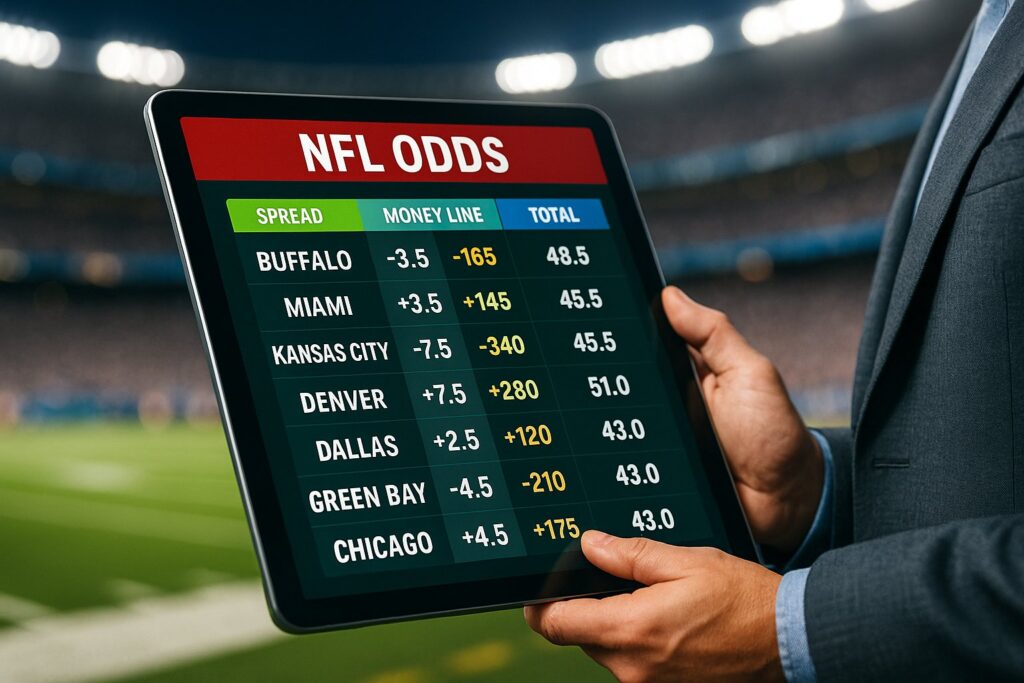Last Updated on August 17, 2025 by Martin Green
Preseason 1
| Date/Time | Matchup | BetOnline | Bovada | bookmaker |
|---|
Preseason 2
| Date/Time | Matchup | BetOnline | Bovada | bookmaker |
|---|
Preseason 3
| Date/Time | Matchup | BetOnline | Bovada | bookmaker |
|---|
Week 1
| Date/Time | Matchup | BetOnline | Bovada | bookmaker |
|---|
Week 2
| Date/Time | Matchup | BetOnline | Bovada | bookmaker |
|---|
Week 3
| Date/Time | Matchup | BetOnline | Bovada | bookmaker |
|---|
Week 4
| Date/Time | Matchup | BetOnline | Bovada | bookmaker |
|---|
Week 5
| Date/Time | Matchup | BetOnline | Bovada | bookmaker |
|---|
Week 6
| Date/Time | Matchup | BetOnline | Bovada | bookmaker |
|---|
Week 7
| Date/Time | Matchup | BetOnline | Bovada | bookmaker |
|---|
Week 8
| Date/Time | Matchup | BetOnline | Bovada | bookmaker |
|---|---|---|---|---|
| Sun 10/26 10:00AM | Miami Dolphins @ Atlanta Falcons | +324 -410 | +320 -430 | |
| Sun 10/26 10:00AM | Chicago Bears @ Baltimore Ravens | +237 -290 | +240 -290 | |
| Sun 10/26 10:00AM | Buffalo Bills @ Carolina Panthers | -380 +303 | -410 +305 | |
| Sun 10/26 10:00AM | New York Jets @ Cincinnati Bengals | +245 -300 | +255 -310 | |
| Sun 10/26 10:00AM | Cleveland Browns @ New England Patriots | +285 -355 | +295 -390 | |
| Sun 10/26 10:00AM | San Francisco 49ers @ Houston Texans | +115 -135 | +115 -135 | |
| Sun 10/26 10:00AM | New York Giants @ Philadelphia Eagles | +292 -365 | +280 -360 | |
| Sun 10/26 1:05PM | Tampa Bay Buccaneers @ New Orleans Saints | -210 +180 | -210 +175 | |
| Sun 10/26 1:25PM | Dallas Cowboys @ Denver Broncos | +149 -170 | +150 -175 | |
| Sun 10/26 1:25PM | Tennessee Titans @ Indianapolis Colts | +836 -1400 | +775 -1500 | |
| Sun 10/26 5:20PM | Green Bay Packers @ Pittsburgh Steelers | -165 +145 | -160 +135 | |
| Mon 10/27 5:15PM | Washington Commanders @ Kansas City Chiefs | +546 -775 | +550 -850 |
Week 9
| Date/Time | Matchup | BetOnline | Bovada | bookmaker |
|---|---|---|---|---|
| Thu 10/30 5:15PM | Baltimore Ravens @ Miami Dolphins | |||
| Sun 11/2 11:00AM | Atlanta Falcons @ New England Patriots | |||
| Sun 11/2 11:00AM | Carolina Panthers @ Green Bay Packers | |||
| Sun 11/2 11:00AM | Chicago Bears @ Cincinnati Bengals | |||
| Sun 11/2 11:00AM | Denver Broncos @ Houston Texans | |||
| Sun 11/2 11:00AM | Minnesota Vikings @ Detroit Lions | |||
| Sun 11/2 11:00AM | Indianapolis Colts @ Pittsburgh Steelers | |||
| Sun 11/2 11:00AM | Los Angeles Chargers @ Tennessee Titans | |||
| Sun 11/2 11:00AM | San Francisco 49ers @ New York Giants | |||
| Sun 11/2 2:05PM | Jacksonville Jaguars @ Las Vegas Raiders | |||
| Sun 11/2 2:05PM | New Orleans Saints @ Los Angeles Rams | |||
| Sun 11/2 2:25PM | Kansas City Chiefs @ Buffalo Bills | |||
| Sun 11/2 6:20PM | Seattle Seahawks @ Washington Commanders | |||
| Mon 11/3 6:15PM | Arizona Cardinals @ Dallas Cowboys |
Week 10
| Date/Time | Matchup | BetOnline | Bovada | bookmaker |
|---|
Week 11
| Date/Time | Matchup | BetOnline | Bovada | bookmaker |
|---|
Week 12
| Date/Time | Matchup | BetOnline | Bovada | bookmaker |
|---|
Week 13
| Date/Time | Matchup | BetOnline | Bovada | bookmaker |
|---|
Week 14
| Date/Time | Matchup | BetOnline | Bovada | bookmaker |
|---|
Week 15
| Date/Time | Matchup | BetOnline | Bovada | bookmaker |
|---|
Week 16
| Date/Time | Matchup | BetOnline | Bovada | bookmaker |
|---|
Week 17
| Date/Time | Matchup | BetOnline | Bovada | bookmaker |
|---|
Week 18
| Date/Time | Matchup | BetOnline | Bovada | bookmaker |
|---|
NFL odds shape how every game is viewed, from opening kickoff to the final whistle. They show the point spread, moneyline, and totals that sportsbooks set for each matchup. NFL odds tell you how much risk is involved and what payout you can expect when placing a bet.
If you get how spreads, moneylines, and over/unders work, you can start to see the value behind each line. Odds move around as sportsbooks react to injuries, weather, or betting trends, so it’s smart to compare numbers across different platforms.
Odds aren’t just for single games, either. Futures cover season-long bets, while live odds shift during play, opening up new chances with every drive. If you know how to read and compare these numbers, following the season gets a lot more strategic and, honestly, a lot more fun.

Key Takeaways
- NFL odds show the risk and potential payout of each bet
- Comparing lines across sportsbooks helps find better value
- Odds change before and during games, creating new opportunities
Understanding NFL Odds
NFL odds show which team is favored, how much a bettor can win, and the likelihood of each outcome. They’re the backbone for point spreads, moneylines, and totals – the big three when it comes to betting on NFL games.
What Are NFL Odds
Sportsbooks set NFL odds to show both the expected outcome of a game and the possible payout. These numbers aren’t just plucked from thin air – they balance betting action with the real probability of results.
Let’s say a strong team gets listed as a favorite with a negative number, while the underdog shows up with a positive number. That’s how books try to even things out between teams of different strengths.
Odds give bettors a snapshot of risk and reward. If you see a favorite at -150, you’ve got to put more money down to win less. On the flip side, an underdog at +150 pays more if they pull off the win – but, of course, it’s riskier.
So, NFL odds predict the game’s outcome and give you the formula for calculating payouts. They’re at the core of every NFL betting line you’ll see.
How Odds Are Calculated
Oddsmakers look at team performance, injuries, matchups, and stuff like the weather to set NFL odds. They dig into historical trends and run stats through models to estimate what’s likely to happen.
Once they set the opening line, sportsbooks keep tweaking it based on where the money goes. If everybody’s piling in on one side, the line shifts to draw more action on the other. This helps the book avoid taking a huge hit if the crowd’s right.
For example, maybe a team opens at -3.5. If a ton of bets come in on them, the spread might jump to -4 or -4.5. Even small changes like that can shift the value of a bet, even though the actual game hasn’t changed.
Don’t forget the “vig” or “juice,” either. That’s the sportsbook’s cut. Standard odds of -110 mean you need to risk $110 to win $100, so the book makes money no matter what happens.
Types of NFL Odds Formats
You’ll see NFL odds in a few different flavors: American, Decimal, and Fractional. In the U.S., American odds rule, but internationally, decimal or fractional formats are pretty common.
- American odds: Positive and negative numbers (like -120 or +150). Negative means favorite, positive means underdog.
- Decimal odds: Big in Europe. Shows what you get back per $1 bet. For example, 2.50 means a $1 bet returns $2.50 if you win.
- Fractional odds: You’ll see these in the UK. Shows profit compared to your stake. So, 3/2 means a $2 bet wins you $3.
The format just changes how the odds look, not what they mean. If you’re comparing NFL lines across different books, you might need to convert between formats. Plenty of sites offer calculators and tools to make that painless.
Knowing each format helps you read NFL betting odds correctly, wherever you find them.
Key Types of NFL Betting Lines
NFL odds usually boil down to three big lines: the spread, the moneyline, and the total. Each one lets you bet on a game in a different way, and understanding how they work can help you make smarter picks.
Spread Betting Explained
The spread is a classic NFL betting line. Sportsbooks set a point margin – the favorite has to win by that much, while the underdog just needs to keep it closer or win outright.
Say a team is at -6.5. They’ve got to win by 7 or more for your bet to cash. The underdog at +6.5 can lose by 6 or less (or win), and you’re golden.
Spreads balance out the action. Instead of just picking a winner, you’re looking at the margin of victory. That makes lopsided matchups way more interesting for bettors.
Key points:
- Negative number (-): Favorite – must win by more than the spread.
- Positive number (+): Underdog – can lose by less than the spread or win.
- Push: If the spread is a whole number and the margin lands right on it, bets get refunded.
Moneyline Bets
The moneyline is as simple as it gets. You just pick who wins – no worrying about the score or margin.
Favorites show up with negative odds (like -150), so you’ve got to risk $150 to win $100. Underdogs have positive odds (like +200), so a $100 bet nets you $200 if they pull off the upset.
This style is great for tight games where the spread is small, or if you’ve got a hunch an underdog might surprise everyone.
Moneyline odds give you a sense of probability. If a team’s at -300, the sportsbook thinks they’re way more likely to win than an underdog at +250.
Totals (Over/Under) Wagers
Totals, or Over/Under bets, are all about the combined score. Sportsbooks pick a number, and you decide if the real total goes over or under.
If the total is 46.5 and the final is 27-24, that’s 51 points – the Over wins. But if the score is 20-17, the Under cashes with just 37 points.
Totals factor in offense, defense, and even the weather. Rain, wind, or snow can slow things down, while dome stadiums might bump up the numbers.
What’s cool is you don’t have to pick a team. You’re just betting on the game’s tempo and scoring style.
Key notes:
- Over: Combined score beats the set number.
- Under: Combined score lands below the set number.
- Half points (.5): No ties or pushes on totals.
How to Read NFL Point Spreads
Point spreads in NFL betting show the gap between the favorite and the underdog. They predict the margin of victory and aim to balance out betting on both sides. If you want to get how spreads work, you need to know how favorites and underdogs are marked, how lines can shift, and how pushes or those sneaky half-points come into play.
Favorite vs Underdog
The spread gives a negative number (-) to the favorite and a positive number (+) to the underdog. The favorite has to win by more than the spread for your bet to pay. The underdog can win outright or just keep it closer than the spread.
For example:
| Team | Spread | Result Needed to Cover |
|---|---|---|
| Cowboys -6.5 | Win by 7+ points | Favorite covers |
| Giants +6.5 | Lose by 6 or less, or win | Underdog covers |
Sportsbooks use spreads to balance action on both sides. A -110 line is pretty standard, so you’re risking $110 to win $100. That extra bit is the “vig,” the book’s cut.
Line Movement
NFL lines shift all the time between opening and kickoff. This line movement can happen because of injuries, weather, or just a flood of bets on one side. If a favorite starts at -3 and everyone jumps on them, the line might slide to -4.5.
Line movement matters. If you grab a favorite at -3, you’ve got a better shot at covering than someone who waits and gets -4.5. Watching these changes helps you spot when to jump in.
Sometimes, books adjust the odds attached to the spread instead of moving the number itself. That’s called shading the line and can hint at where they expect the money to land.
Pushes and Half-Points
A push happens when the favorite wins by exactly the spread. If the spread is -7 and the favorite wins by 7, everyone gets their money back. That’s more common with whole-number spreads.
To dodge pushes, sportsbooks often use half-points like -6.5 or +3.5. These “hooks” make sure there’s a clear winner or loser for each side. A -3.5 spread? The favorite has to win by 4 or more – a win by 3 won’t cut it.
Half-points make things more precise and cut down on ties, but they can also swing results in a big way. Bettors keep a close eye on these hooks, especially around numbers like 3 and 7 since those are common winning margins in NFL games.
Comparing NFL Odds Across Sportsbooks
NFL odds can look different from book to book, and even tiny differences can add up over time. If you compare lines, you’ll spot better prices, lower your risk, and get more mileage out of your bets.
Why Compare Odds
It’s rare for every sportsbook to post the exact same line for an NFL game. You might see a spread at -3.5 at one sportsbook but -3 at another – that half-point can really matter.
Small edges like that can turn a loss into a push or even a win. Betting a favorite at -3 instead of -3.5 gives you a better shot at covering.
Moneyline odds bounce around, too. One book might offer +120, while another sits at +115. Over a season, always grabbing the better price could mean hundreds or thousands more in profit.
Comparing odds isn’t about chasing every tiny advantage, but it’s smart to make a habit of finding the best available line. That way, you’re squeezing more value from every bet without taking on extra risk.
How to Shop for the Best Lines
Start by opening accounts at a few legal sportsbooks – DraftKings, FanDuel, Caesars, BetMGM, you name it. With options, you can compare prices before you bet.
Odds comparison tools and apps make life easier. They show live NFL odds from a bunch of books all at once, so you can spot the best spread, total, or moneyline in seconds.
Try this quick checklist:
- Check spreads at 2-3 sportsbooks.
- Compare totals for any half-point differences.
- Review moneylines for the best return.
Timing matters, too. Early-week lines might be softer, while closer to kickoff, public money can shift things. If you track movement, you’ll know when to lock in the best number.
Understanding Line Differences
Line differences pop up for a bunch of reasons. Sportsbooks shift odds depending on betting action, local fan bases, and how fast they catch news about injuries or roster changes.
Say a sportsbook has a lot of home-team fans betting – they’ll probably nudge the line toward that side. Another book might see things differently, so you’ll find gaps in the odds.
Books handle risk in their own ways. One might move the spread fast after sharp bettors jump in, while another waits for more bets to roll in. If you shop around, you can spot these differences and maybe grab a better price.
Even totals and props aren’t immune. You might see a total at 45.5 points on one site and 46 somewhere else. If you want the over, you take the lower number. If you’re eyeing the under, the higher number’s better. It’s a small edge, but it adds up.
Live NFL Odds and In-Game Betting
Live NFL odds jump around as the game unfolds. Sportsbooks tweak lines on the fly, reacting to momentum swings, injuries, and scoring plays that could change everything.
How Live Odds Work
Live odds update right away during NFL games. Sportsbooks lean on data feeds, in-game stats, and betting action to adjust spreads, moneylines, and totals. The numbers you see in the first quarter might look nothing like what you get by halftime.
If a favorite falls behind early, for example, the live point spread might shrink or even flip. A lopsided moneyline could suddenly even out. These moves reflect both what’s happening on the field and how bettors are reacting.
Some key types of live betting odds:
- Point Spread: Adjusts expected margin of victory.
- Moneyline: Updates payouts for either team to win outright.
- Totals (Over/Under): Shifts with the scoring pace.
Since these odds can move in seconds, timing matters a lot. If you hesitate, you might miss the number you wanted.
Strategies for In-Game Betting
If you want to do well with in-game betting, you’ve got to stay sharp. Watch how teams adjust after turnovers, injuries, or coaching calls—those moments are when the odds might lag and give you a shot at value.
Pace of play matters too. Fast offenses can push totals up, while a grind-it-out game will drag them down. If you spot these trends early, you might catch a better line than everyone else.
Lots of folks compare live odds across different sportsbooks. Even a half-point on a spread or a tiny shift in the moneyline can change your risk and reward. Using more than one platform gives you a better shot at grabbing the best number out there.
It’s smart to have a plan before you start betting live. Decide which games or teams you want to target ahead of time so you don’t end up chasing bets just because you’re caught up in the action. That bit of structure can help you avoid blowing up your bankroll in the heat of the moment.
NFL Futures and Season-Long Odds
NFL futures let you bet on outcomes that play out over the whole season. These usually cover championship winners, division or conference champs, and player awards. Unlike your weekly bets, futures odds shift as teams win, lose, or deal with injuries.
Super Bowl Odds
Super Bowl odds are always the hottest futures market. Sportsbooks post them months before the season, so you can bet early or wait for things to shake out midseason.
Favorites usually have big-name quarterbacks, tough defenses, or recent playoff runs. Teams like the Kansas City Chiefs or San Francisco 49ers tend to sit near the top.
Underdogs offer longer odds and bigger potential payouts. Some bettors like to take a shot on mid-tier teams that could surprise. Odds update every week as results, injuries, and public bets roll in.
Here’s a simple look at Super Bowl futures odds:
| Team | Odds |
|---|---|
| Kansas City Chiefs | +550 |
| San Francisco 49ers | +600 |
| Buffalo Bills | +900 |
| Dallas Cowboys | +1200 |
| Chicago Bears | +4000 |
These numbers show the implied chance of winning – shorter odds mean higher expectations.
Division and Conference Odds
Division and conference odds narrow things down compared to the Super Bowl market. Each division has four teams, and sportsbooks set lines based on projected wins, schedules, and rosters.
The AFC East, for instance, often has tight odds between the Buffalo Bills and Miami Dolphins. In the NFC North, things can flip fast if a team like the Detroit Lions gets hot.
Conference odds work the same way, but cover all teams in the AFC or NFC. If you think a team will make the Super Bowl but not necessarily win, you might prefer betting the conference market.
Divisional races can swing after just a game or two, so these odds move more often than Super Bowl lines.
Player Futures
Player futures focus on individual awards and stats. You’ll see markets for MVP, Offensive Rookie of the Year, Defensive Player of the Year, and season-long leaders in passing yards or rushing touchdowns.
Quarterbacks usually dominate MVP odds, with guys like Patrick Mahomes or Josh Allen leading the pack. Running backs and wide receivers only crack the top if they put up crazy numbers.
Rookie awards are interesting since odds can shift fast once a first-year player gets rolling. A rookie QB who starts early and plays well can see his odds improve a lot after just a few games.
Player stat futures, like total passing yards, give you a target to root for. Health, consistency, and offensive schemes matter a ton here, so these bets are risky but can be fun if you follow certain players closely.
Bankroll Management for NFL Betting
Managing your money is huge in sports betting. It helps you limit risk, protect your funds, and make smarter decisions. The basics: set aside a bankroll just for betting, pick a smart bet size, and avoid mistakes that drain your cash too fast.
Setting a Budget
Your bankroll is the total amount you put aside just for betting. Keep it separate from your regular money, and think of it as entertainment cash you can lose without sweating it.
Lots of bettors set their bankroll before the NFL season starts. Maybe that’s $1,000 for the season, and that’s the max they’re willing to lose.
Some quick tips for setting your budget:
- Only use money you can afford to lose.
- Keep betting cash away from your bills or savings.
- Decide if you want a season-long bankroll or reset it monthly.
This way, you avoid chasing losses with extra money and always know your limit.
Unit Sizing
Once you’ve got your bankroll, figure out how much to bet each time – that’s your unit. Most people risk 1-2% of their bankroll per bet.
With a $1,000 bankroll, one unit would be $10 (1%). This keeps your bets steady and avoids wild swings.
Some stick with flat betting, where every bet is the same size. Others adjust a bit based on confidence, but staying in that 1-2% range helps you ride out the ups and downs.
Here’s a quick table:
| Bankroll | 1% Unit | 2% Unit |
|---|---|---|
| $500 | $5 | $10 |
| $1,000 | $10 | $20 |
| $5,000 | $50 | $100 |
This way, you never risk too much on a single game.
Avoiding Common Mistakes
Plenty of bettors hurt their bankroll with avoidable mistakes. Chasing losses is a big one – it usually means bigger bets and worse decisions.
Another is bumping up your bet size after a hot streak. It feels good in the moment, but it can backfire fast.
Other common errors:
- Not tracking your results.
- Ignoring your limits when things are going well.
- Letting emotions call the shots instead of sticking to your plan.
If you keep your bets steady and follow your plan, you’re way less likely to lose control of your bankroll during the NFL season.
Analyzing NFL Betting Trends
NFL betting trends show where the public is putting their money and how sportsbooks respond. These patterns can help you spot value in the odds and see how market opinions shift before kickoff.
Public Betting Percentages
Public betting percentages track how many bets and how much money go to each side. For example, maybe one team gets 70% of tickets but only 55% of the money. That tells you casual fans and big bettors might not agree.
Sportsbooks share these splits to show both the number of bets and the total money. Bettors use this info to see if the public is piling on a favorite or an underdog.
When most of the public lines up on one side, sportsbooks might move the odds to even things out. Sometimes, that opens up value on the less popular team.
Key things bettors watch:
- Ticket percentage = number of bets
- Handle percentage = total money
- Big gaps might mean sharp money is coming in
Tracking these numbers helps you see if a line is shaped by public bias or more informed bettors.
Line Movement Insights
Line movement shows how sportsbooks change odds and spreads as bets come in and new info drops. Early moves usually mean sharp bettors are pushing the market, while late changes are often from public money close to game time.
If a spread opens at -3 and moves to -4.5, there’s probably heavy action on the favorite. If the odds shift toward the underdog even though most bets are on the favorite, sharp bettors might be driving that.
Some things that move lines:
- Injuries or roster updates
- Weather that could affect scoring
- Betting volume from both the public and pros
If you know why a line moved, you can decide if the current odds are worth it or if waiting could get you a better number. Watching these changes gives you a peek at how the market thinks – not just the final spread.
NFL Odds for Halves and Quarters
NFL lines aren’t just about full-game spreads and totals. You can also bet on specific halves and quarters, which lets you focus on game flow, team habits, or in-game changes.
First Half and Second Half Lines
Sportsbooks usually post first half lines before kickoff. These odds cover the first two quarters – spread, moneyline, and total. It’s a way to bet on how teams start. Sometimes, a team with a strong offense will be favored in the first half even if the full-game line is close.
Second half lines come out at halftime. Oddsmakers set these based on the score, injuries, and momentum. You can react to what you’ve already seen. If a favorite falls behind early, the second half spread might shift and give you a new angle.
These bets work well if you track scoring trends. Some teams start hot, others fade late. By looking at first half and second half odds, you can find spots where the adjusted line gives you more value than the original full-game spread.
Quarter Betting Options
Quarter lines chop the game into four smaller segments. Each quarter gets its own spread, total, and sometimes a moneyline. These odds cover a shorter stretch, so they’re more volatile – but honestly, that’s part of the fun if you want to zero in on certain moments.
Say you like a team that always comes out firing in the first quarter – you might back them early. Or maybe you trust a team to rally in the fourth quarter when it counts. Quarter betting odds often shift based on pace, coaching, and who’s actually on the field.
Some sportsbooks let you bet quarters live. Odds update right along with the action, so you can react if you spot a mismatch or momentum swing. Since each quarter stands alone, whatever happens in one doesn’t mess with the next line.
Quarter betting really lets you dig into short-term trends. If you like focusing on specific stretches instead of whole games, this approach is up your alley.
Legal and Responsible NFL Betting
You can find NFL betting just about everywhere in the US these days, but the rules change depending on where you are. Oversight stays tight, and honestly, it should – you want to keep things safe and fun.
Legal Considerations by State
More than half the states allow NFL betting, but every state writes its own playbook. Some go all-in with online and retail sportsbooks. Others stick to in-person bets at casinos. And yeah, a handful still ban it outright.
For example:
| State Type | Example States | Availability |
|---|---|---|
| Full Online + Retail | New Jersey, Pennsylvania, Michigan | Mobile apps and casinos |
| Retail Only | Mississippi, Montana | On-site sportsbooks only |
| Not Legal | Utah, Idaho | No legal betting options |
States require sportsbooks to get licensed and regulated locally. That’s how you get fair odds, secure payments, and some peace of mind. Always check if a sportsbook has the state’s stamp of approval before you bet.
States also differ on what bets you can make. Some limit wagers on college teams or player props. Others open things up a bit more. It’s worth double-checking the local rules so you don’t accidentally cross a line.
Responsible Gambling Tips
Responsible gambling really just means knowing your limits and sticking to them. Only bet what you can afford to lose, and treat it as entertainment – not a side hustle.
Here’s what helps:
- Set a budget before you start, and don’t break it.
- Track your time and spending on betting sites.
- Don’t chase losses – that spiral rarely ends well.
- Try sportsbook tools like deposit limits, time-outs, or even self-exclusion if you need a break.
Most states make sportsbooks link to support services like the National Council on Problem Gambling. If you ever need help, you can reach out via hotline, chat, or local programs – all confidential.
Frequently Asked Questions
Oddsmakers set NFL betting lines using a mix of data, analysis, and what the market expects. Most bettors look at spreads, totals, moneylines, and outside stuff like injuries or weather before making any picks.
How are point spreads determined for NFL games?
Oddsmakers compare teams using power ratings, stats, and past matchups. They factor in home-field advantage and anything else that might swing things. Once they post the first line, sharp bettors and the public can move it as sportsbooks try to balance their risk.
What factors influence the over/under lines in NFL betting?
Totals come from projecting how many points both teams might score together. Oddsmakers weigh offensive and defensive matchups, pace, and how efficiently teams finish drives.
Weather, injuries, and coaching style can all nudge those numbers up or down.
How does the moneyline work in NFL wagering?
The moneyline shows the odds for each team to win outright. A minus sign (-) means you have to risk more to win less – that’s the favorite. A plus sign (+) marks the underdog, so you get a bigger payout if they pull off the win.
What are the best strategies for betting on NFL games?
Successful bettors usually shop around at different sportsbooks to find the best line. They care more about value than just picking winners. Following line movement, digging into matchups, and managing your bankroll all matter too.
How do injuries and weather conditions affect NFL betting odds?
When a quarterback, key player, or a bunch of starters go down, sportsbooks move the line fast. They adjust odds based on how much missing players might impact the game.
Weather can shake things up as well. Heavy wind, rain, or snow often pushes totals down. If conditions are mild, you might see higher-scoring games.
What does ‘juice’ or ‘vig’ mean in the context of NFL betting?
Juice, or vig, is basically the commission a sportsbook tacks onto each bet. That’s how they make sure they turn a profit, as long as the betting action stays balanced.
Say you see a standard line of -110. That just means you’ve got to risk $110 to win $100, and that extra $10? That’s the sportsbook’s cut.










